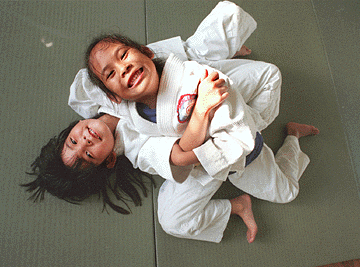
Maile Hong, 6, left, and Skye Nakamura, 7,
at Moiliili Community Center. Photo by Dennis Oda, Star-Bulletin

Maile Hong, 6, left, and Skye Nakamura, 7,
at Moiliili Community Center. Photo by Dennis Oda, Star-Bulletin
Graffiti, for example, never used to be a problem.
Once a stable community of single-family homes, Moiliili became more of a transitory neighborhood once the apartments and highrises came in.
Today, "it's a lower-income and lower-middle-income area," Ryan said. "It used to be predominantly Japanese, now there are many Vietnamese, Koreans, Thai. There are a large number of single-parent households."
The center celebrated its 50th anniversary last year and remains the soul of the community. But just as the community has evolved into a multi-ethnic neighborhood, so, too, has the center's clientele and services changed. Only about 60 students are enrolled today in Japanese School, from which the center sprang, and these days, there's belly dancing as well as bon dancing offered there.
After 46 years, Moiliili Community Center is symbolic of the baby boomer generation, who finds itself sandwiched between aging parents and young children.
On any given day, Moiliili Community Center has programs for about 600 adults, from active seniors to the frail elderly, and about 660 youngsters.
"The center really has a life of its own," Ryan said. "In the day time, the seniors come in the morning and leave about 11:30, after lunch. The kids come in at 2:30 for Japanese school and afterschool programs. In the evening, the Jaycees and other service organizations use it; there are board meetings and dance classes, martial arts classes. On weekends, there are educational activities and church groups.
But with continuing cuts in government support, "We're refocusing our community role," Ryan said. "A lot of emphasis is coming back to the community."
The center has been a focal point of the community for more than 90 years, dating back to its start as a tuition-free Japanese school, founded by Kihachi and Shika Kashiwabara.
In 1902, the school was established on land leased from Bishop Estate. In time, it would become the largest community Japanese language school in the islands, with more than 1,000 students.
When World War II broke, the school and anything connected with the Japanese became suspect. To prevent the military from confiscating the school property, Boy Scoutmaster Harry Yoshimura, now 92, moved his Troop 2 from Mother Rice Pre-school into one of the language school's buildings, to show officials that it served a broader community.
Another key figure in saving the school was Kinji Kanazawa, 80 next month, who convinced six powerful non-Japanese businessmen to replace himself and other Japanese on the school's board of directors. The replacements voluntarily gave up their positions once the war ended.
In 1945, the Moiliili Japanese Language School transferred its land and assets to the Moiliili Community Association. Gradually, the ethnic barrier dissolved as the association began to develop recreational, social and cultural programs. In 1965, the association formally became the Moiliili Community Center.
"My philosophy was that this was property our fathers donated - well beyond what they could afford - to establish a school for the community," Kanazawa said, explaining his love for the center.
To him, Japanese school was a source of family cultural teachings and a moral code of conduct, focusing on obligation, respect and social commitment.
"That's why I always felt Moiliili Japanese School property is an important asset to the Moililiil community," he said.